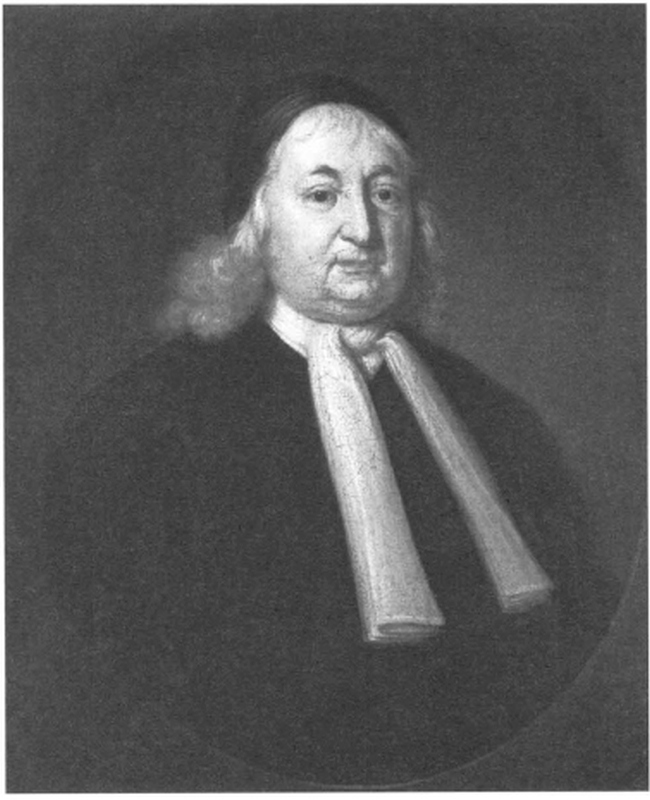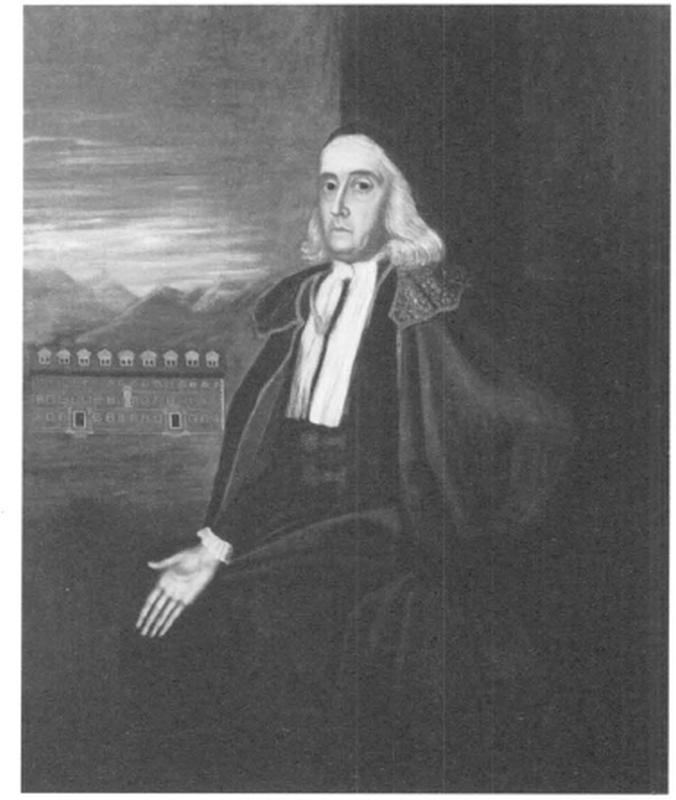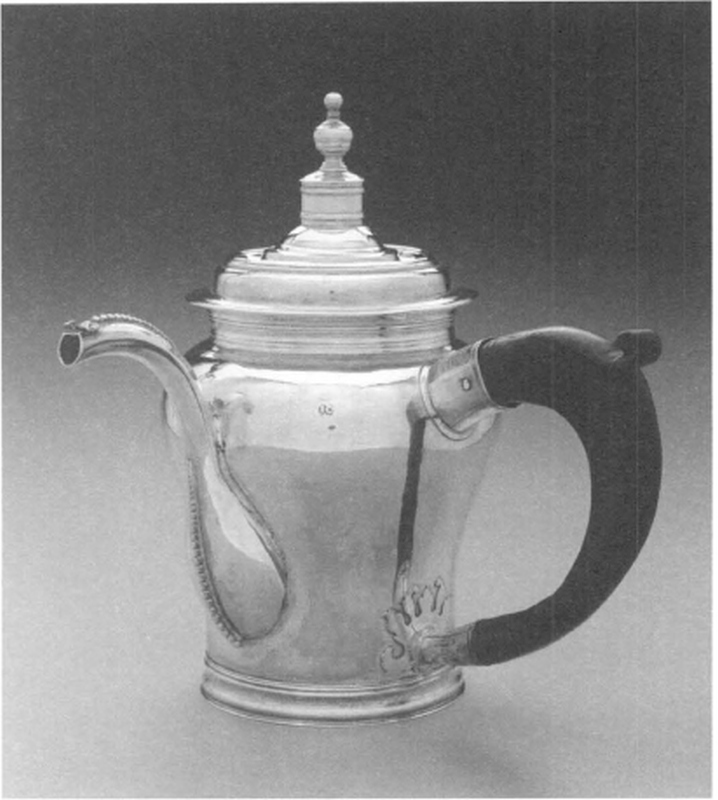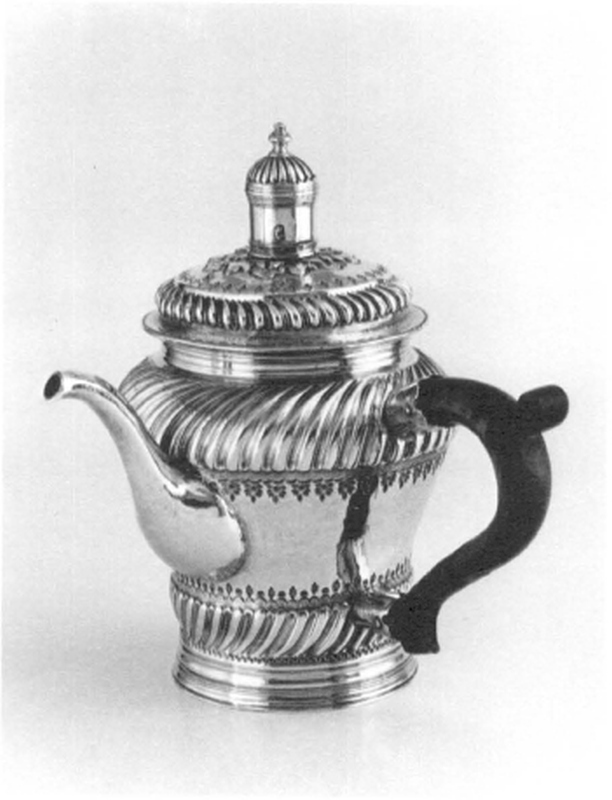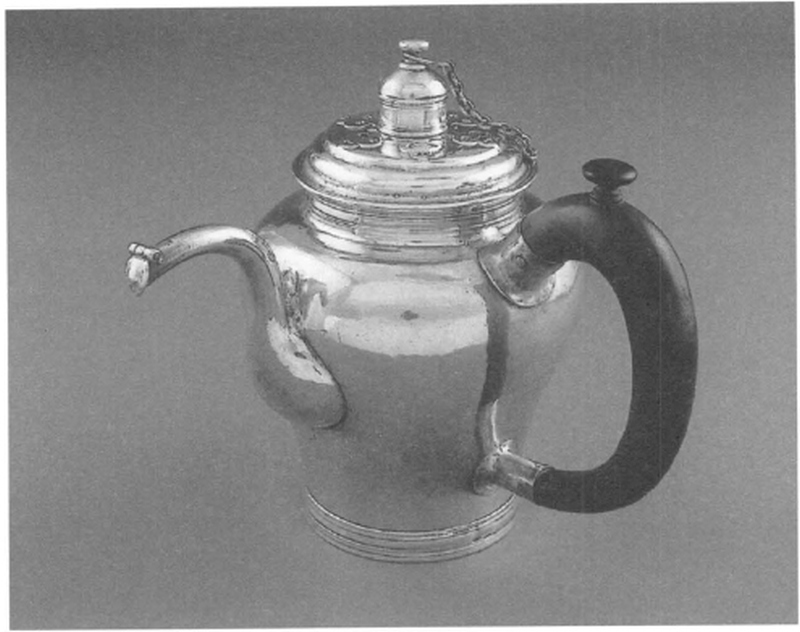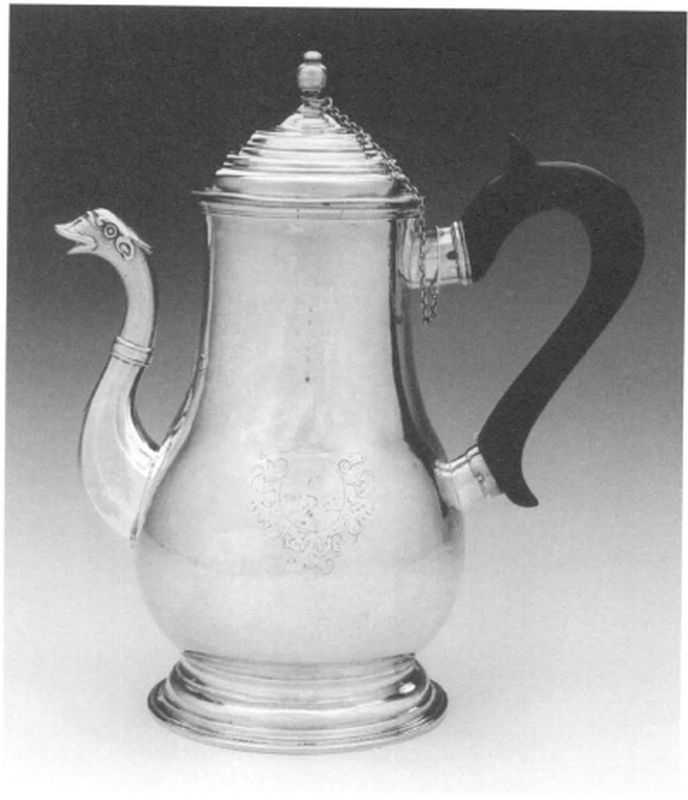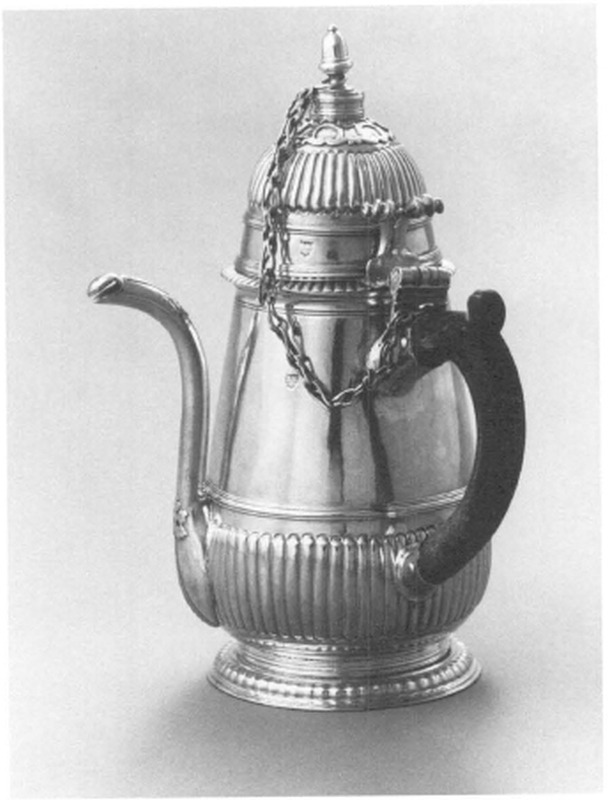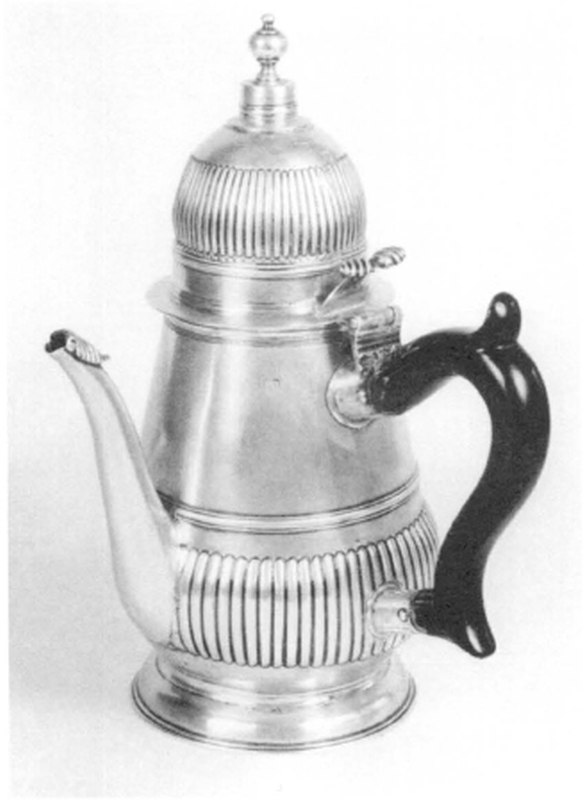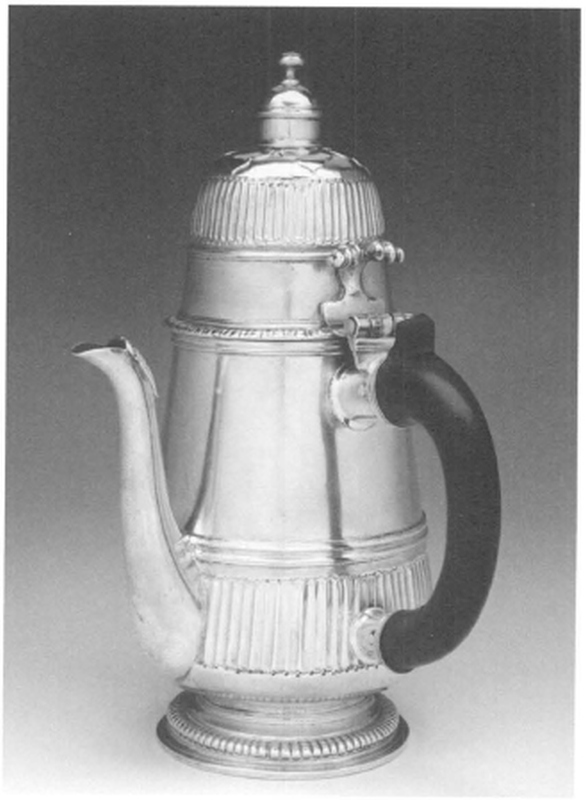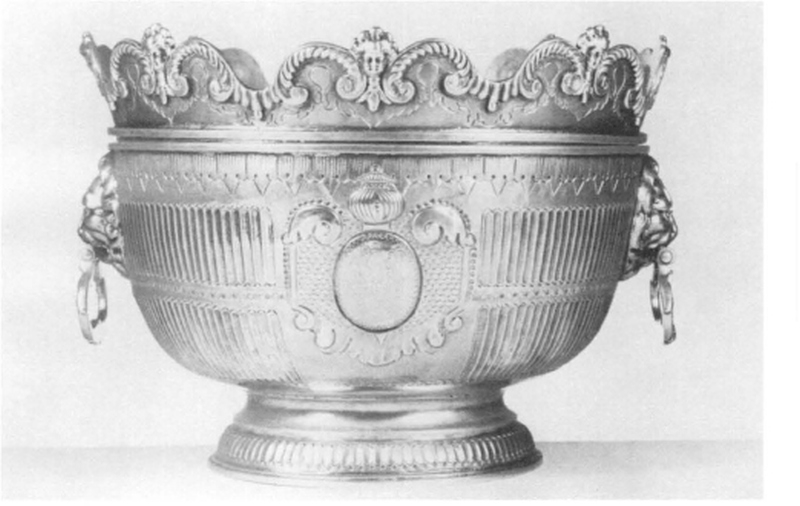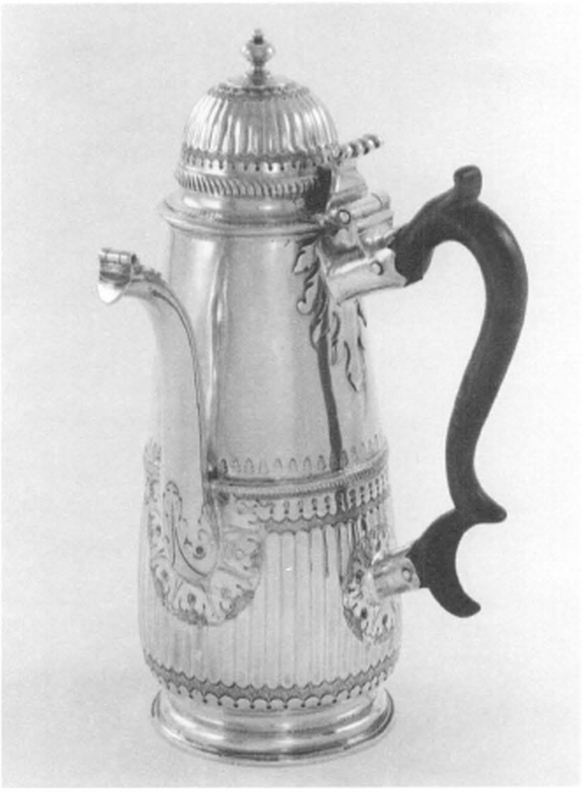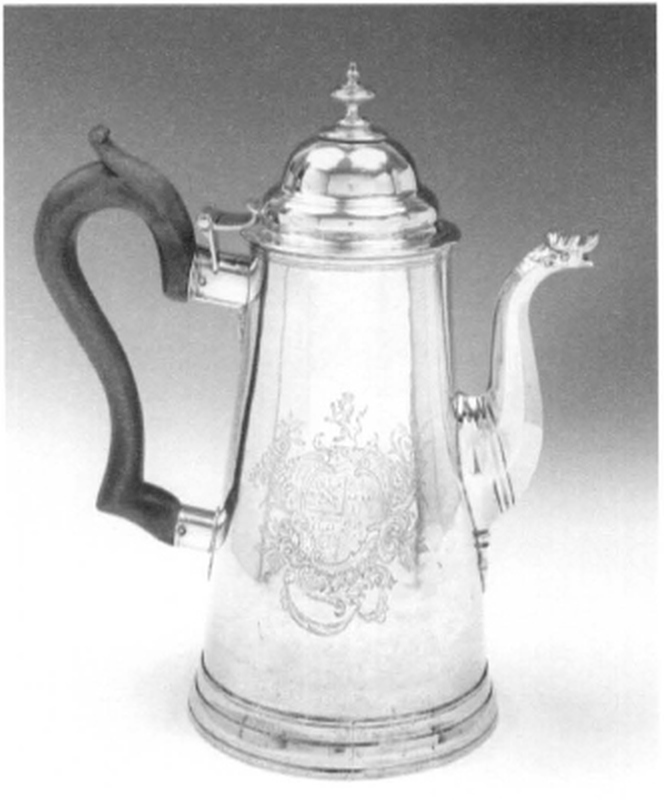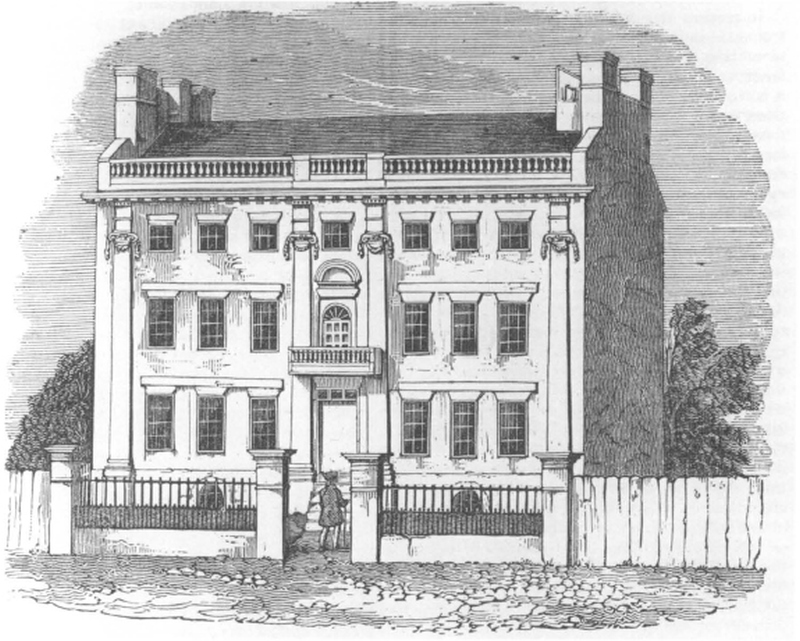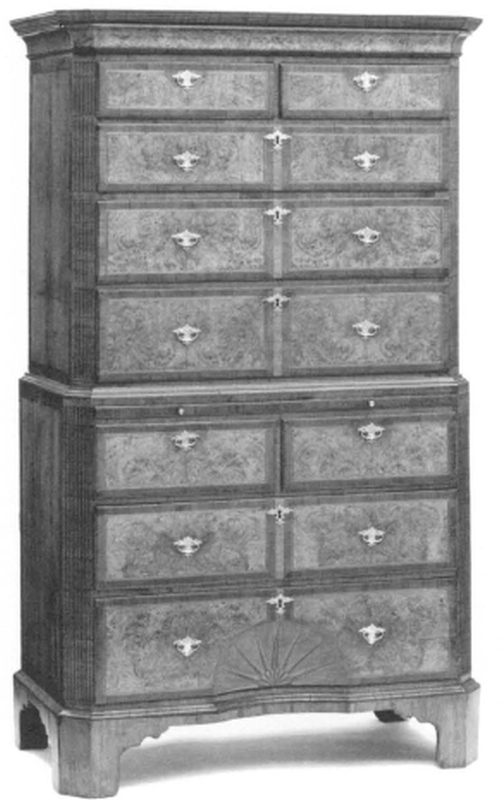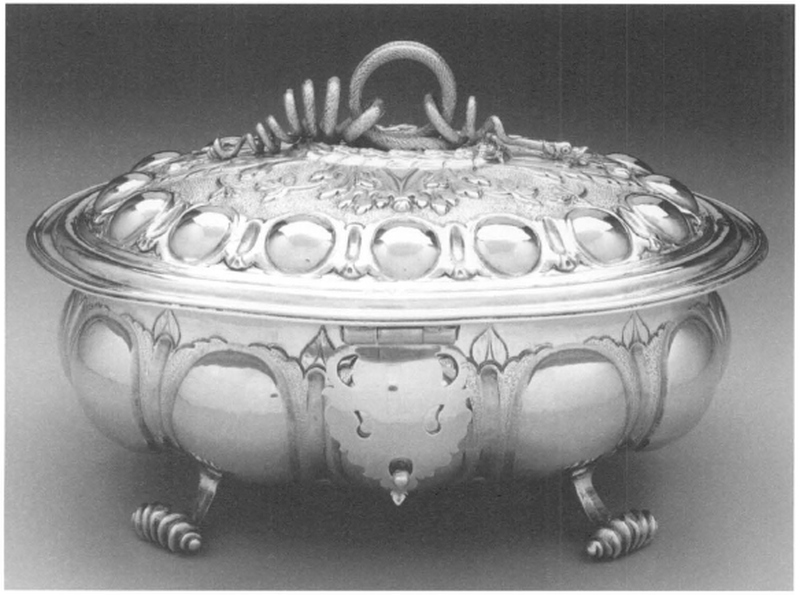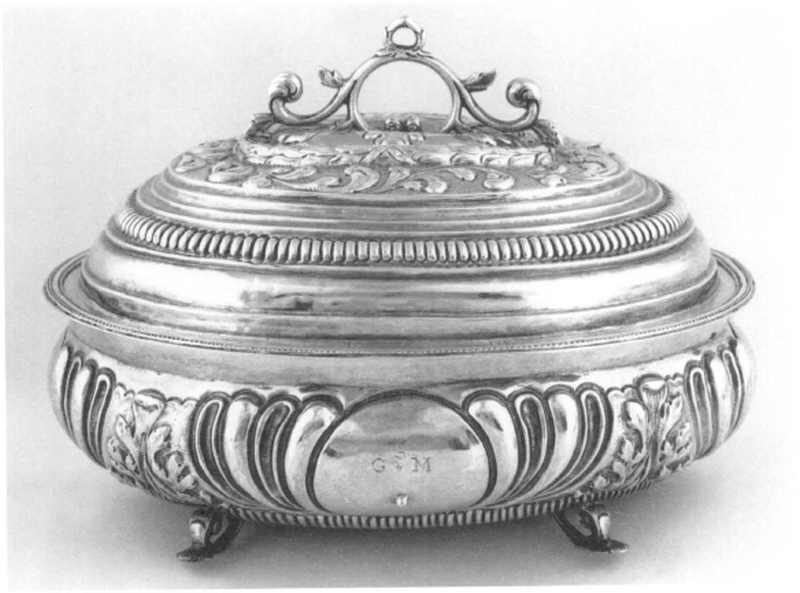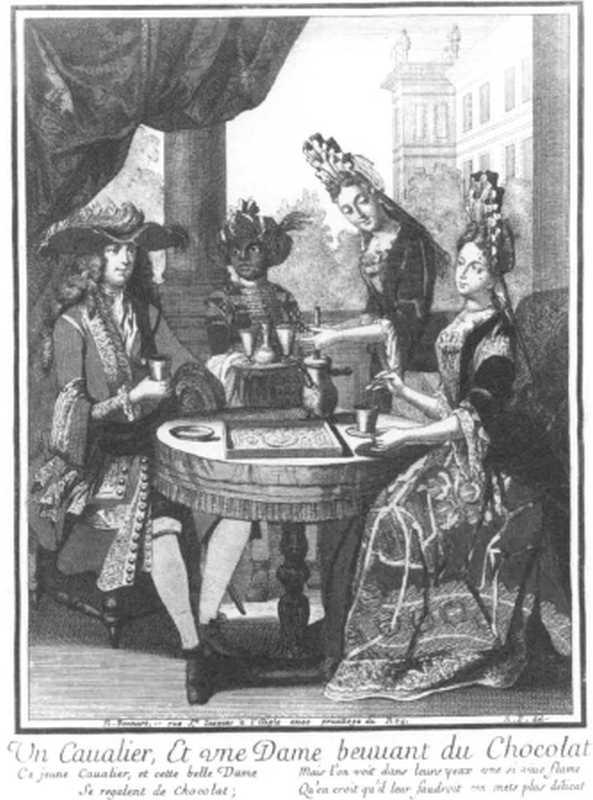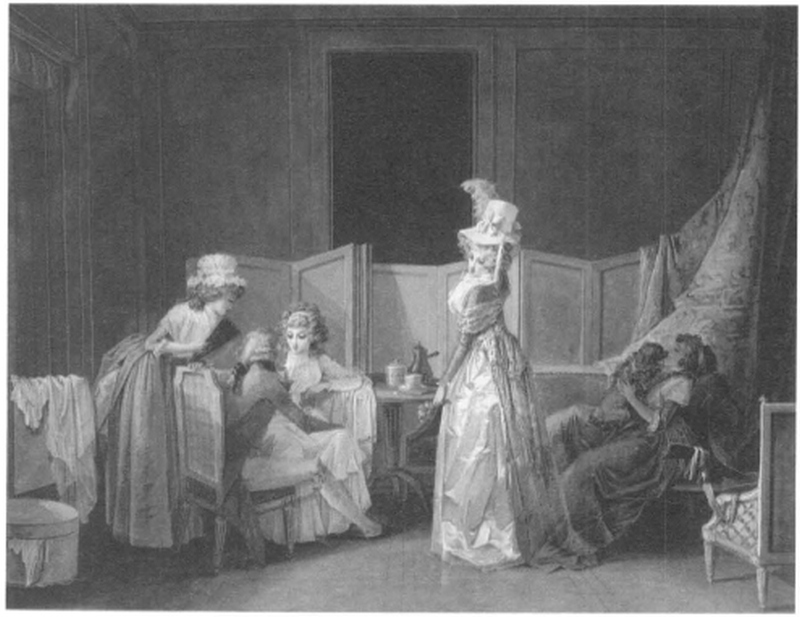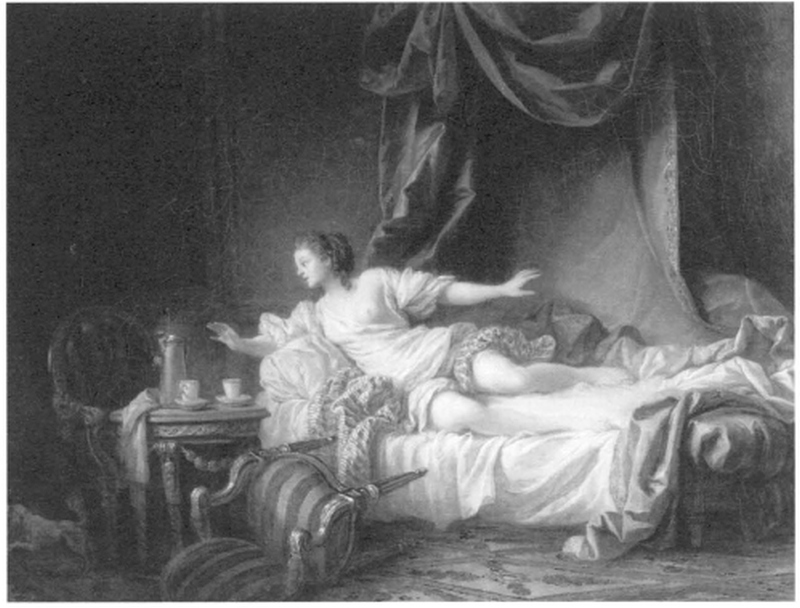The Silver Chocolate Pots of Colonial Boston
Gerald W. R. Ward
Tea, coffee, and chocolate—three drinks we now take for granted—were introduced to England and North America in the seventeenth century. Initially considered exotic beverages, each arrived in the Anglo-American world from a remote part of the globe. Tea came from the Orient, coffee from North Africa and the Middle East. Chocolate was the gift of Mexico, Central America, and South America; it first arrived in Spain in the sixteenth century and then migrated to France, England, and the rest of Europe, before making the trip to North America and to our area of concern here, New England, through the West Indies trade. Flavorful, rich, and nutritious, chocolate was indeed a boon to the seventeenth and eighteenth-century diet. Usually consumed as a beverage in those days, chocolate was “of a dusky colour, soft, and oily; usually drank hot, and esteemed not only an excellent food, as being very nourishing, but also a good medicine; at least a diet, for keeping up the warmth of the stomach, and assisting digestion.” Wealthy consumers and silversmiths responded to this expensive novelty in the Anglo-American world by demanding and creating a specialized form—the chocolate pot—to be used for serving this luxurious new drink.1
Most scholars give 1657 as the date of the first documented instance of chocolate’s appearance in London.2 By the 1660s, Samuel Pepys took chocolate frequently there, often at breakfast, as on May 3, 1664, when he “went to Mr. Blands and there drinking my morning draught in good chocolate, and slabbering my band sent home for another.”3 It seems likely that chocolate appeared in Boston not long after it arrived in England. In the winter of 1667–68, the merchant and goldsmith John Hull was trading in cocoa and tobacco, and in 1670, chocolate was common enough in town that the Boston selectmen approved the separate petitions of two women, Dorothy Jones and Jane Barnard, “to keepe a house of publique Entertainment for the sellinge of Coffee and Chucalettoe.” These women and other individuals were granted similar licenses in the years following, as chocolate became a more standard item on the bill of fare in public establishments.4
In typical New England fashion, chocolate was too enjoyable to be considered entirely respectable. In 1676, Benjamin Tompson (1642–1714), a largely forgotten New England poet, wrote a lengthy poem entitled “New-Englands Crisis,” published right in the middle of the bloody conflict known to the English colonists as King Philip’s War. Tompson laments that the “golden times” of New England have passed—that the strength of the Puritan forebears had been “quickly sin’d away for love of gold.” Citizens once noted for their strong character and religious piety have been corrupted by licentiousness and idle pleasures. Chocolate figures into his elegy. Remembering the past, he recalled the days before outside influences worked their evil ways. This age, he recalled,
Twas ere the Islands sent their Presents in,
Which but to use was counted next to sin.
Twas ere a Barge had made so rich a fraight
as Chocholatte, dust-gold and bitts of eight.
He further blames “fruits and dilicacies” from “western Isles” that “Did rot maids teeth and spoil their hansome faces.” Despite such concerns, chocolate soon became accepted, even among the Puritan elite.5
Samuel Sewall (1652–1730) of Boston (fig. 1) mentions chocolate several times in his famous diary and in so doing gives us our first glimpses of chocolate drinking as a form of social interaction in New England. On October 20, 1697, he visited Lieutenant Governor William Stoughton (fig. 2) in Dorchester, and they had “breakfast together on Venison and Chockalatte.” Sewall observed that “Massachusetts and Mexico met at his Honour’s Table.”6 On October 1, 1709, Sewall went to Mr. Belcher’s in Dedham, where in the morning he drank “warm chockelat, and no Beer; find my self much refresh’d by it after great Sweating to day, and yesterday.”7 On other occasions, as revealed by entries in his diary and letter-book, Sewall gave gifts of chocolate to friends. In April 1687, for example, he bought “21 balls [of] chokolatto,” probably to be shipped in linen bags in chunks known as balls, rowls, lumps, cakes, or tablets in the contemporary literature.8 These balls may have resembled the irregular pieces of chocolate depicted in the lower right side of a still-life painting of 1770 by the Spanish artist Luis Melendez (fig. 3). In 1707, for example, he “gave Mr. Solomon Stoddard two half pounds of Chockalat, instead of Commencement Cake,” and on another occasion in 1723 he presented a new mother with a gift of “two pounds of Chockalet.” Sewall also gave silver objects as gifts, and his use of chocolate for similar presentation purposes suggests its high social status.9
Other Bostonians no doubt shared Sewall’s enjoyment of chocolate. The Reverend Thomas Prince (1687–1758), minister of Old South Church and historian of early New England, made it part of his daily routine. Following graduation from Harvard, Prince spent a decade abroad before returning to Boston in 1717 and assuming his position at Old South the next year. After his marriage, he drew up his plans in 1719 for carrying out each day. His “proposed order” called for rising at 5 a.m. and spending an hour in prayer and reading the Bible in his study, after which he would wake up the rest of the family. At 6:30, they would have family prayers, and then “only the Porringer of Chocolat for Breakfast,” before setting out on an arduous day.10
Fig. 1. John Smibert (1688–1751), Judge Samuel Sewall, 1729. Oil on canvas; h. 30 in., w. 25 in. Museum of Fine Arts, Boston, bequest of William L. Barnard (by exchange), and Emily L. Ainsley Fund (58.358).
Prince’s porringer of “Chocolat” and the “warm chockelat” Sewall enjoyed were probably prepared with equipment and utensils of the type depicted in the Melendez painting (see fig. 3), following directions of the kind described in an English publication of 1675 by John Worlidge. Some people “boil [the chocolate] in water and sugar; others mix half water and half milk and boil it, then add powdered chocolate to it and boil them together; others add wine and water.” “Be sure,” the author continues, “whilst it is boiling to keep it stirring, and when it is off the fire, whir it with your hand mill [the mill being a stick, sometimes of silver or another material but usually wooden, with a flange on one end, used for stirring the thick chocolate mixture; sometimes referred to as a molinet]. That is, it must be mixed in a deep pot of Tin, copper [as in the Melendez painting] or stone [stoneware], with a cover with a hole in the middle of it, for the handle of the mill to come out at, or without a cover. The mill is only a knop at the end of slender handle or stick, turned in a turner’s lathe, and cut in notches, or rough at the end. They are sold at turners for that purpose. This being whirled between your hands, whilst the pot is over the fire, and the rough end in the liquor causes an equal mixture of the liquor with the chocolate and raises a head of froth over it. Then pour it out for use in small dishes for that purpose. You must add a convenient quantity of sugar to the mixture.”11
Fig. 2. Unknown artist, William Stoughton (1631/32–1701), ca. 1700. Oil on canvas; h. 49⅜ in., w. 45¼ in. Courtesy of the Harvard University Portrait Collection. Gift of John Cooper to Harvard College, 1810 (H037). © President and Fellows of Harvard College, Harvard University.
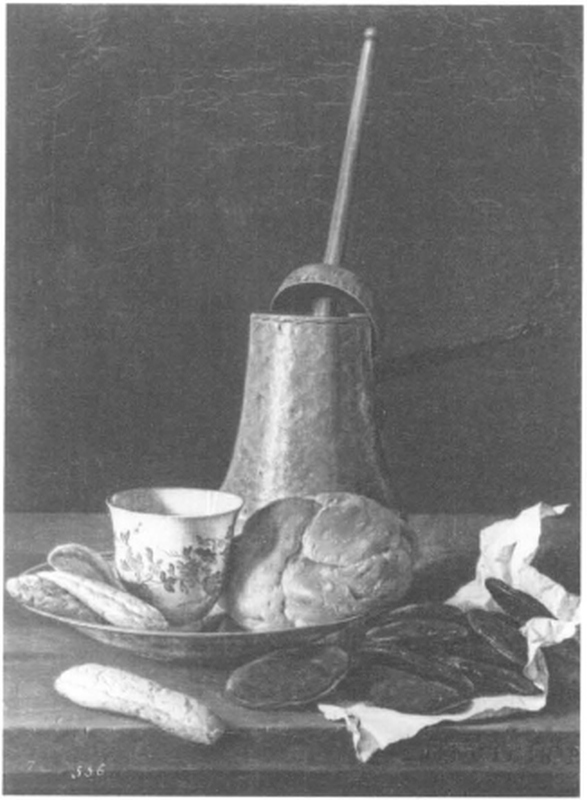
Fig. 3. Luis Melendez (1716–1780), Still Life of Chocolate Service, ca. 1760. Oil on canvas; h. 18⅞ in., w. 143⁄16 in. Museo del Prado, Madrid.
In this passage the author has identified the distinguishing characteristic of a chocolate pot—the opening in the lid which allows for the insertion of the essential stirring rod. The opening can be achieved in a variety of ways—by a removable cap or finial, or the presence of a small hole accessed by a sliding cover—but it must be present in order to consider an object a chocolate (as opposed to a coffee or tea) pot. The sediment in hot chocolate—unlike that in tea and coffee—is desirable, and thus the mixture needs to be stirred continually. Otherwise, chocolate pots and coffee pots—both usually taller and generally larger than teapots—are virtually indistinguishable. For example, each form was made with the spout in line with the handle, or occasionally with the spout at a right angle to the handle.
The basic recipe outlined by Worlidge changed little for more than a century, although many methods of preparation must have been used by individuals. Although chocolate was probably prepared in a copper or brass pot in large quantities and perhaps served in a ceramic or base-metal pouring vessel, in a few of the most fashionable New England homes chocolate was served in a silver chocolate pot. The earliest reference to such an object in Boston conies in 1690, when William Pleay owned a “jocolato pot.”12 Only eight examples made in colonial Boston are known to have survived; a potential ninth example, unknown today, has been published as both a chocolate and a coffeepot. Their rarity is underlined by the fact that chocolate pots represent only an infinitesimal percentage of the more than six thousand pieces of extant silver made by colonial Massachusetts silversmiths.13
Despite their low numbers, the Boston silver chocolate pots—especially the six made before 1720 by John Coney, Edward Winslow, Edward Webb, and Peter Oliver—provide a glimpse of life in Boston during a period of florescence in the decorative arts. Extraordinarily stylish and costly, the pots were faddish in their response to a new custom. Used in the process of consuming a luxurious beverage in a custom that migrated from Catholic Spain and southern Europe, silver chocolate pots seem almost antithetical in Protestant Boston, yet their existence—when taken into account with other stylish forms of silver, furniture, and architecture—is a small slice of material evidence of the changes, ultimately dramatic in their extent, that were moving Boston from its origins as a Puritan enclave in the seventeenth century to its place as a cosmopolitan, sophisticated, commercial colonial city in the very earliest years of the eighteenth century.
Fig. 4. John Coney (1655/56–1722), chocolate pot, Boston, Massachusetts, 1701. Silver; h. 81⁄16 in., diam. (base) 3⅝ in. Museum of Fine Arts, Boston, Gift of Edwin Jackson Holmes (29.1091).
The Boston Chocolate Pots
Of this group of eight, the earliest example is probably the one made by John Coney about 1701 (fig. 4). It is engraved on the bottom “The gift of Wm Stoughton Esquire / to Mrs. Sarah Tailer : 701,” presumably in error for 1701. In his will, executed on July 6, 1701, Lt. Gov. Stoughton left his niece, Mrs. Sarah Byfield Tailer, twelve pounds to buy a piece of plate as a “particular remembrance” of him, and presumably this vessel is the result of that bequest. It may have been a fitting choice, for Stoughton (see fig. 2) is known to have enjoyed a cup of chocolate at breakfast with Samuel Sewall, and he may have had a fondness for the drink. In form, this Coney pot resembles an Oriental vase, and it would have been virtually at the height of fashion in London and smaller English towns when it was made. It has its handles at right angles to the spout, as many (but not all) examples do, perhaps to facilitate stirring while pouring. The turned-ball finial covers the hole necessary for insertion of the stirring rod. The curved spout originally had a hinged lid at the end, now lost, that perhaps helped to keep the contents warm. The Coney pot is further distinguished by its cut-card ornament around the base.14
Fig. 5. Isaac Dighton (w. 1697–99), chocolate pot, London, 1697. Silver; h. 7¾ in. Metropolitan Museum of Art, New York, Gift of George O. May, 1943 (43.108).
Sarah Tailer was the wife of Lieutenant Governor William Tailer (1677–1732). Their household included many stylish goods, including two English cane chairs that have survived (one in the Massachusetts Historical Society and the other in the Bostonian Society); these were probably among eighteen such chairs in the fashionable Tailer household.15
An English example (fig. 5), made by Isaac Dighton of London in 1697, provides a high-style analogue to the Coney pot, with its more elaborate gadrooning and other ornament and its gilt surface. A London pot made by George Garthorne (fig. 6) in 1686 is more similar to the Coney example, and some provincial English examples, like one made by R. Williamson of Leeds about 1695, are also close in feeling. In other words, Coney’s work, while not at the highest level of court silver, was nevertheless stylish and up-to-date in the Anglo-American community.16
Fig. 6. George Garthorne (d. 1730), chocolate pot, London, 1686. Silver; h. 7¾ in. Private collection. Photo, courtesy David B. Nicolay, New Orleans Auction Galleries, Inc.
Coney, who was probably apprenticed to Jeremiah Dummer, was the leading Boston goldsmith of his day. His work included rare forms such as sugar boxes, punch bowls, and monteith bowls, as well as the earliest known American silver teapot, and thus it is not surprising that a second chocolate pot by him is known (fig. 7). This example was probably made between 1715 and 1720, as indicated by its curvilinear pear-shaped body in the incipient late baroque taste. Its most decorative feature is its serpent-headed spout. This pot originally had a sliding or pivoted finial for the insertion of the stirring rod, and the underside of its base shows a circular pattern of wear that suggests the pot was often placed on a small brazier or chafing dish to keep it warm. The original owners of this pot, unfortunately, are not known—their initials have been erased and replaced with those of William Downes and his wife, Elizabeth Edwards Cheever, who were not married until 1749. This Coney example also has its counterparts in English work.17
Fig. 7. John Coney (1655/56–1722), chocolate pot, ca. 1710–22. Silver; h. 97⁄16 in., diam. (base) 47⁄16 in., Museum of Fine Arts, Boston. Partial gift of Dr. Lamar Soutter, Theodora Wilbour Fund in memory of Charlotte Beebe Wilbour, and the Marion E. Davis Fund (1976.771).
Perhaps the most beautiful American chocolate pot was made by Edward Winslow of Boston between 1700 and 1710 (fig. 8). It is richly decorated with gadrooned ornament that is played off of plain areas, creating what the silver scholar John Marshall Phillips of Yale University called the beautiful counterpoise of baroque silver. This pot, now in the Metropolitan Museum of Art, has an acorn finial that unscrews and is then held in place by a chain. It was owned originally by Thomas Hutchinson (1675–1739), a wealthy merchant and husband of Sarah Foster, the daughter of Colonel John Foster. They were the parents of the notorious Tory Governor Thomas Hutchinson.18
Another Winslow pot, very similar to the one in the Metropolitan Museum, is now in the collection of the Yale University Art Gallery (fig. 9). Also made in the first decade of the eighteenth century, the Yale Winslow pot has had its spout moved to a higher location on the body, perhaps as early as 1740—the hole where the original spout was located was patched with a decorative plaque. This alteration probably had its origins in the function of the object. A higher location for the spout allowed for sediment to settle more easily in the pot, and thus the change may have allowed the chocolate to flow more smoothly. The Yale Winslow pot is engraved with what are thought to be the Auchmuty family arms; if such is the case, the pot’s original owner may have been lawyer Robert Auchmuty (1687–1750) of Roxbury.19
Fig. 8. Edward Winslow (1669–1753), chocolate pot, Boston, Massachusetts, ca. 1705. Silver; h. 9½ in. Metropolitan Museum of Art, New York, bequest of Judge A. T. Clearwater, 1933 (33.120.221).
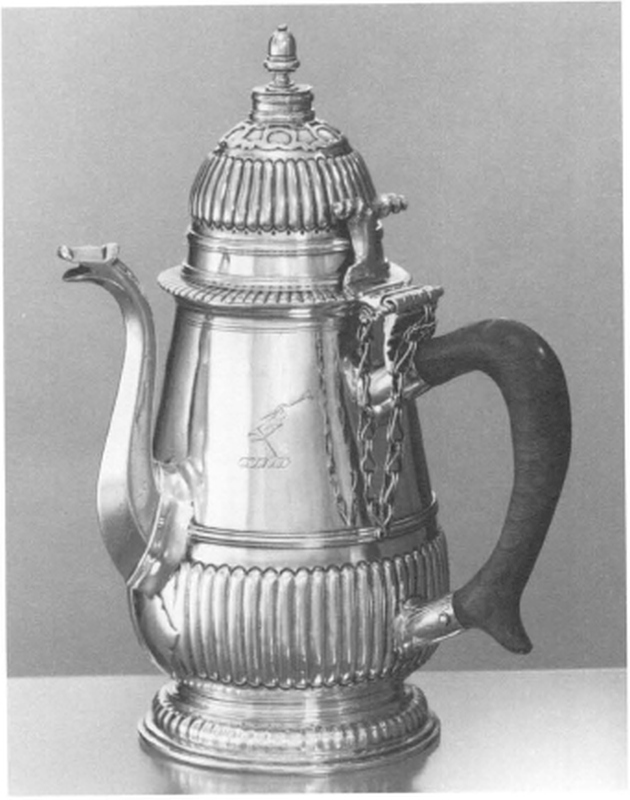
Fig. 9. Edward Winslow (1669–1753), chocolate pot, Boston, Massachusetts, ca. 1705. Silver; h. 99⁄16 in. Yale University Art Gallery, Mabel Brady Garvan Collection (1944.71).
Fig. 10. Peter Oliver (ca. 1682–1712), chocolate pot, Boston, Massachusetts, ca. 1705. Silver; h. 10⅜ in. From B. K. McLanathan, ed., Colonial Silversmiths, Masters and Apprentices (Boston: Museum of Fine Arts, Boston, 1956), cat. no. 111, fig. 45. Photo, courtesy Museum of Fine Arts, Boston.
A fifth Boston silver chocolate pot was made by Peter Oliver, who died at the young age of thirty and left only about seven examples of his work behind (fig. 10). Oliver was probably apprenticed to Coney, “his trusty friend.” His chocolate pot must have been made in the short period of time between the completion of Oliver’s training in about 1703 and his death in 1712. Visually, Oliver’s pot is similar to the Winslow examples, sharing the use of gadrooned ornament, and the finial, originally removable, has been soldered in place. The pot was probably made for Beulah Jacquett, who married Thomas Coates, and then it subsequently descended in their family in the female line through many generations.20
Edward Webb was the maker of a sixth Boston silver chocolate pot (fig. 11). While it bears an overall resemblance to the Winslow and Oliver examples, it has some significant differences. It has an unusual finial assembly, consisting essentially of a screw-on cap, and it has fluted, rather than gadrooned, ornament on its body and cover. Webb, born in England about 1666, learned his craft in London during an apprenticeship to William Denny. Denny had opened shop in London in 1679 and worked there until his death in 1709. He had just entered into business when Webb started his training in 1680, which lasted until about 1687. Denny’s prominent shop filled many important commissions, and Webb was thus exposed to sophisticated English silver styles during his formative years there. It is possible that Webb stayed on in Denny’s shop as a journeyman. Objects that have Denny’s mark, like a monteith dated 1702 (fig. 12) and others dated about the same time, often bear the type of fluting—the tight, somewhat pinched, irregular, almost nervous fluting—that Webb must have learned in Denny’s shop and brought to America. It is not known when Webb arrived in this country, although evidence places him here as early as 1704. Most other objects bearing Webb’s mark, including tankards, porringers, and spoons, are simpler than the chocolate pot. Some of them have well-executed cast ornament, but none is as ambitious as the pot. However, Webb was a wealthy man when he died in 1718, and his estate inventory indicates that he owned all the tools necessary to create such a complex pot. As an English immigrant and one with specialized skills, Webb may have worked primarily as a jobber or journeyman for native-born silversmiths. Although the writer is not aware of any chocolate pots bearing William Denny’s mark that resemble the Webb pot, some contemporaneous English work, such as an example of 1703 by William Charnelhouse of London (fig. 13), is closely related. Unfortunately, the original owner of the Webb pot is not known. The applied cartouche on the side of the pot is a later addition of uncertain, although possibly eighteenth-century, date, and the engraved initials it bears, P / TA, remain unidentified.21
Fig. 11. Edward Webb (ca. 1666–1718), chocolate pot, Boston, Massachusetts, ca. 1710. Silver; h. 10 in. Museum of Fine Arts, Boston, Gift of a Friend of the Department of American Decorative Arts and Sculpture, and Marion E. Davis Fund (1993.61).
Fig. 12. William Denny, monteith, London, 1702. Silver; diam. 10 in. From Georgina E. Lee, with assistance from Ronald A. Lee, British Silver Monteith Bowls including American and European Examples (Byfleet, Eng.: Manor House Press, 1978), 36, fig. 31. Photo, courtesy Museum of Fine Arts, Boston.
The last two Boston colonial chocolate pots known were made by Zachariah Brigden, one in the Museum of Fine Arts (fig. 14) and the other at Historic Deerfield (fig. 15), both dated to about 1755–60 and thus made very early in Brigden’s career. The MFA Brigden pot was made for Ebenezer and Mary (Edwards) Storer, who were married in 1723, and is engraved with the coat of arms used by Ebenezer.22 The Deerfield Brigden example, which is slightly larger but otherwise very similar, was made for a member of the De(e)ring family.23 Both have removable finials; the MFA example has an open-link chain to secure the finial when it is removed. Brigden’s chocolate pots, last in the Boston series, document the survival of their kind for more than half a century, into the era when tea and coffee pots were the more common forms.
Provincial Luxury
This group of eight objects—perhaps statistically insignificant even when one considers that undoubtedly a few examples have been lost to the melting pot in the last two centuries—is of extraordinary significance when considered in light of developments in Boston in the colonial era, especially in the years 1700 to 1715 or 1720, when all but the Brigden pots were made. As the seventeenth century came to a close, changes began to be felt in the small seaport town of about ten thousand people. “The worldwide commercial interests of the town,” according to the historian G. B. Warden, “did provide luxuries and diversions from Augustan England which seriously affected the town’s way of life.”24 Many of these “luxuries and diversions” were brought to Boston by the succession of royal governors and other officials who administered the province’s affairs after 1692. Changes in architecture, furniture, silver, and other furnishings took place, and the little cluster of chocolate pots is perhaps best seen as part of a constellation of material objects, large and small, that introduced new styles, customs, and behaviors to Boston.
Fig. 13. William Charnelhouse (d. 1711/12), coffeepot, London, 1703/4. Silver; h. 95⁄16 in. Sterling and Francine Clark Art Institute, Williamstown, Massachusetts (1955.281).
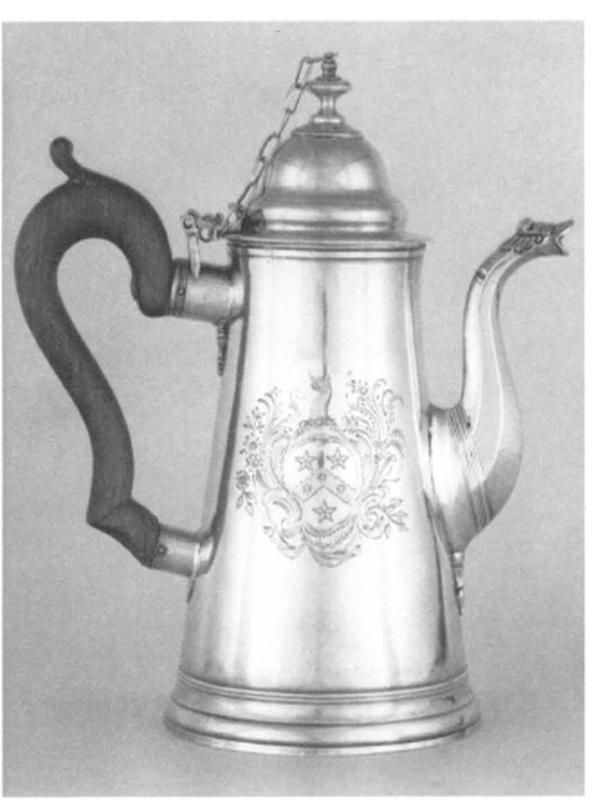
Fig. 14. Zachariah Brigden (1734–1787), chocolate pot, Boston, Massachusetts, ca. 1755–60. Silver; h. 9⅞ in. Museum of Fine Arts, Boston, Gift of the Misses Rose and Elizabeth Townsend (56.676).
Fig. 15. Zachariah Brigden (1734–1787), chocolate pot, Boston, Massachusetts, ca. 1755–60. Silver; h. 10⅝ in. Historic Deerfield, Inc. (75.463).
The house built in 1679 by Peter Sargeant was probably the grandest house in Massachusetts in its time and for many years thereafter. In the 1710s, it was remodelled to become the fashionable city home of the colonial governors and became known as the Province House. Portraits of kings, queens, and governors hung in its council chambers, and it symbolized the existing power structure in Boston. It also was the epicenter of the increased urbanization and sophistication that characterized Boston in this period.25
The Foster-Hutchinson house (fig. 16), built on Garden Court Street in the North End about 1692 (and destroyed in 1833), is representative of this new wave of change. As Abbott Lowell Cummings has observed, the Foster-Hutchinson house is the first “recorded example of the English Renaissance in Boston,” with its Ionic pilasters topped by capitals of imported Portland stone.26 The house is central to our theme because it was built by John and Abigail Foster, and descended to Mrs. Foster’s nephew, the merchant-captain Thomas Hutchinson, the owner of the Winslow chocolate pot now at the Metropolitan (see fig. 8). The Foster-Hutchinson house stood next door to the Clark-Frankland house, built by the merchant William Clark about 1712. (It, too, was taken down in 1832 or 1833.) This three-story brick mansion was an even more fully developed example of the Georgian style, with its string courses, rhythmic facade, and alternating segmental and triangular pediments. Many less ambitious houses, like the Moses Pierce-Hichborn house of ca. 1711, which still stands in the North End, came from the same mold, as were collegiate buildings at Harvard and churches and civic buildings in Boston, such as the landmark building now known as the Old State House of 1712–13.27
Fig. 16. Foster-Hutchinson House, Boston, Massachusetts, 1689–92. From The American Magazine of Useful & Entertaining Knowledge (February 1836). Courtesy of the Trustees of the Boston Public Library.
Fig. 17. Chest-on-chest, Boston, Massachusetts, 1715–25. Black walnut, burl walnut veneer, eastern white pine; h. 70¾ in., w. 42¼ in., d. 21½ in. Museum of Fine Arts, Boston, Gift of a Friend of the Department of American Decorative Arts and Sculpture, and Otis Norcross Fund (1986.240).
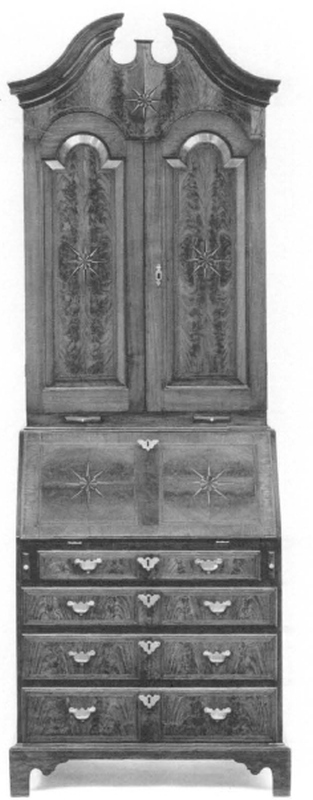
Fig. 18. Desk and bookcase, Boston, Massachusetts, ca. 1715–20. Walnut, walnut veneer, eastern white pine; h. 88½ in., w. 29⅝ in., d. 20½ in. Museum of Fine Arts, Boston, The M. and M. Karolik Collection of Eighteenth-Century American Arts (39.176).
Fig. 19. John Coney (1655/56–1722), sugar box, Boston, Massachusetts, 1680–90. Silver; h. 413⁄16 in., w. 7¾ in., d. 6 in. Museum of Fine Arts, Boston, Gift of Mrs. Joseph Richmond Churchill (13.421).
These developments in architecture, in which the Georgian style supplanted the timber-frame first-period buildings of the post-medieval style, started to transform the landscape. They were mirrored in changes in furniture and furnishings that similarly began to affect domestic space. Such objects as the Warland family chest-on-chest (fig. 17) and the Reverend John Avery’s desk and bookcase (fig. 18) are key to understanding Boston furniture of possibly as early as 1715. Both are very English in style, and advanced stylistically. Edward S. Cooke, Jr., has suggested that they are the cabinetmaking equivalent of the elaborate Boston silver made by Coney, Winslow, and others—silver that includes the sophisticated group of chocolate pots, as well as other notable examples of conspicuous consumption, such as the wrought candlesticks of 1690–1710 by Coney and gadrooned candlesticks by John Noyes of about 1695–1700, lighting devices rarely made in silver in this country. Other rare forms made in this period include John Coney’s spectacular monteith (made about 1705–10 for rinsing and cooling wineglasses) and his simple yet elegant punch bowl of about 1710.28
The chocolate pots bear perhaps the most significant relationship to Boston silver sugar boxes, a similarly small group of ten known examples, including ones by John Coney of ca. 1685 (fig. 19) and Edward Winslow of about 1700 (fig. 20). Both forms are rare, costly, stylish, and linked to relatively short-lived customs. The chocolate pots lack the overt snake symbolism and other embellishments that are practically unique to Winslow’s sugar boxes, as explained by Ed Nygren, who explored the complex iconography and sexual connotations of these objects, which are related to issues of marriage, fertility, and fecundity. Although sugar boxes were used primarily in the service of wine, one can imagine a wealthy family using sugar boxes and chocolate pots in the same household, for sugar was also important as a sweetener for the otherwise bitter chocolate.29
Fig. 20. Edward Winslow (1669–1753), sugar box, Boston, Massachusetts, ca. 1700. Silver; h. 5¾ in., w. 8½ in., d. 611⁄16 in. Museum of Fine Arts, Boston, The Philip Leffingwell Spalding Collection. Given in memory by Katharine Ames Spalding and Philip Spalding, Oakes Ames Spalding, Hobart Ames Spalding (42.251).
Both forms also were produced by only a few craftsmen. Of the combined total of eighteen sugar boxes and chocolate pots, Coney (four sugar and two chocolate) and Winslow (five sugar and two chocolate) produced thirteen, or 72 percent; another chocolate pot was made by Peter Oliver, who was probably apprenticed to Coney. It is possible that Coney and Winslow were able to employ a journeyman with experience in London—perhaps Edward Webb or Henry Hurst—to assist in the fashioning of such stylish, sophisticated forms.30
The “Excellent Nectar”
Drinking chocolate was both a private and a public custom. Chocolate was taken at coffee-houses, or houses of public entertainment, in a public setting, although because of its higher price due to high duties, chocolate initially took a secondary role to coffee and was soon almost completely eclipsed by the more caffeine-laden drink. A silver chocolate pot was not necessary, of course, for even though silver’s purity and thermal conductivity made it suitable for hot beverages, base-metal vessels would do as well and were commonly used in these commercial establishments.
In the home, the principal context of silver articles, chocolate was often taken in the morning, at least during the first years after its introduction, but it was undoubtedly used at many times during the day.31 For example, Madam Sarah Kemble Knight (1666–1727) arrived in the evening in a clean, comfortable house in the Narrangansett country while en route in her famous trip from Boston to New Haven in October 1704. The owner of the home asked what Madam Knight would like to eat, and she replied, “I told her I had some Chocolett, if shee would prepare it; which with the help of some Milk, and a little clean brass Kettle, she soon effected to my satisfaction.”32 But the longstanding, fashionable tradition amongst the European-monied class, in a tradition that migrated from the Catholic countries of southern Europe, Italy, and Spain, was to take chocolate in the morning, as Samuel Sewall did at least once and undoubtedly did more frequently. The chocolate was poured, in most cases, from silver pots into ceramic chocolate cups, often small, handleless beakers imported from abroad, although smaller tea cups would serve nearly as well. No doubt a variety of drinking vessels were used. Peter Fanueil (1700–1742/43), reputed to be the wealthiest man in Boston at his death in 1743, who owned some fourteen hundred ounces of silver, served the beverage in “6 lignum vitae chocolate cups lin’d with silver,” and, as we saw earlier, the Rev. Thomas Prince used a porringer.33
Bostonians obtained their chocolate from local merchants, such as Mrs. Hannah Boydell, who offered “Tea, Coffee, Chocolate, Loaf and Muscovado Sugars of all Sorts” at her shop on King Street in the 1730s, or the grocer John Merrett, at the sign of the Three Sugar Loaves and Canister, also on King Street, who sold “Super-fine Chocolate, Coffee, raw and roasted, [and] very choice Teas,” along with all manner of sugars, spices, and other delicacies. Another merchant offered “Italian chocolate ready prepared with sugar” in 1739, and in 1769, John Goldsmith advertised “Choice Chocolate made and Sold” at his corner shop leading down John Hancock’s wharf.34
Although chocolate contains some theobromine, a mild stimulant, it has more nutritional than stimulating value. In its early days, chocolate was also thought to have medicinal value and to be an aphrodisiac.35 (An English verse of 1652 observes that chocolate “Twill make old women Young and Fresh; / Create new notions of the flesh / And cause them long for you know what, / If they but taste of chocolate.”36) But within a few years, chocolate, like tea, which had similarly been given many magical and mystical powers when first introduced, became primarily a fashionable, expensive drink that did not carry a great deal of attendant symbolic meaning. Thus, the French cavalier and lady seen taking chocolate in a French print published between 1690 and 1710 (fig. 21), were primarily simply enjoying themselves in a cabaret.37
Fig. 21. Robert Bonnard, published by Nicolas Bonnart, Un Cavelier et une Dame beuvant du chocolat (Cavalier and Lady Drinking Chocolate), ca. 1690–1710. Engraving on paper; h. 1011⁄16 in., w. 7½ in. Pierpont Morgan Library, New York.
This theme of enjoyment and relaxation typifies many eighteenth-century images of chocolate drinking. A French depiction of a lady’s boudoir—or possibly a brothel—features a chocolate service at its center (fig. 22), for example, with the mill (or molinet) clearly visible. A painting (fig. 23) by the French artist Jean-Baptiste Leprince entitled La crainte (Fear) (1769) depicts a woman in bed leaning toward her departed lover (and her chocolate pot, with its mill clearly visible, and cups). The method of drinking chocolate was to adopt a “fluid, lazy, languid motion,” well typified by this young lady. Dress for taking chocolate was meant to be casual (carried to an extreme in this image).38
Fig. 22. Jean-Baptiste Mallet (1759–1835), La Jolie Visiteuse, ca. 1750, Gouache; h. 10⅞ in., w. 14⅛ in. Museum of Fine Arts, Boston, Forsyth Wickes Collection (65.2585).
Most everything about chocolate drinking suggested ample amounts of leisure time, which is perhaps the greatest symbol of power. The Englishman William Hughes, writing in 1672, cautioned his readers that “it is not convenient, as experience hath sufficiently taught us, to eat or drink any tiling else quickly after the drinking of it; or presently to use any immoderate exercise; but rather to rest awhile, whether it be taken hot or cold: because it is apt to open the Pores, and thereby it causeth the greater expence of Spirits by transpiration, and so consequently nouriseth the less.”39 In other words, take it easy. As the scholar Wolfgang Schivelbusch has observed, a long breakfast involving chocolate “does not start off a workday—rather it marks the start of a day’s carefully cultivated idleness,” a “morning-long awakening to the rigors of studied leisure.”40
Such a style of life—of slow, languorous mornings—was at odds with the Puritan and Yankee modes of behavior, and this divergence may account for the small number of silver chocolate pots made in Massachusetts Bay Certainly the Rev. Prince was not an idle aristocrat—his morning draft of chocolate inaugurated a long day of scholarship and meditation. Coffee was more in tune with New England Protestantism. The silver chocolate pots of Coney, Winslow, Webb, and Oliver allow us to see a few Bostonians, in the first few years of the eighteenth century, trying on a Continental style of life that, apparently, didn’t fit. Although chocolate remained a part of the culinary landscape throughout the eighteenth century, it was not afforded the exalted status of silver pouring vessels, designed and reserved just for chocolate, with the exception of the two Brigden pots made at midcentury. Other forms became more popular in silver. Based on surviving examples, for example, Massachusetts silversmiths are known to have made at least ninety-five silver teapots before about 1775. Most of these, however, were made relatively late. The earliest is one by John Coney of about 1710 and only five others are known that date before 1730. By the middle of the 1730s, there was a real spike in the production of teapots, with at least twenty-five known examples, including many by Jacob Hurd, that can be dated to ca. 1735 to ca. 1745; the numbers continue to increase during the following decades. Silver coffeepots were crafted rarely by Massachusetts silversmiths in the first half of the eighteenth century. Only about six made before 1750 survive, although at least twenty-one are known dating to the period ca. 1750 to ca. 1775. Silver coffeepots or pots of other materials may have been used for chocolate after 1720, but the era when it demanded specialization had largely passed.41
Fig. 23. Jean-Baptiste Le Prince (1734–1781), La crainte (Fear), 1769. Oil on canvas; h. 19¾ in., w. 25¼ in. Toledo Museum of Art, Gift of Edward Drummond Libbey (1970.444).
The historian Cary Carson, in a very lengthy study of the style of life in the eighteenth century, has observed that there was something in the air in the years just before and after 1700. The world was changing, and among the many consequences of those changes, he suggests, “none was more novel or conspicuous than the pleasure that men and women took in their physical well-being and the value they placed on material things.”42 Why this was so remains a matter of debate among historians in the academy, but it is likely that the story of Boston’s silver chocolate pots might add a footnote to the ultimate resolution. Certainly people drank chocolate because it tasted good, and wealthy people apparently took pleasure in using silver vessels to do so. The surviving chocolate pots indicate that the period of 1700 to 1715 was especially significant for these changes in one small area of “cultivated gentility.” Thus, aside from their intrinsic qualities as works of art, these pots have something to add to the current academic concerns about the rise of gentility and genteel behavior in America, about changes in etiquette and manners, and about the ongoing concern in American life over the pernicious effects of luxury.43 They offer information about the consumer revolution, and no doubt, like the story of sugar as told by Sidney Mintz, they say something about power relationships based on wealth and exploitation.44
The thoughts expressed by William Hughes in 1672, however, probably come closer to the true meaning of chocolate to people of the eighteenth century than do our latter-day theoretical speculations. In his volume entitled The American Physitian, or. A Treatise of the Roots, Plants, Trees, Shrubs, Fruit, Herbes, &c. Growing in the English Plantations in America, . . . whereunto is added a Discourse of the Cacao-Nut-Tree, And the use of its Fruit; with all the ways of making Chocolate, the like never extant before, Hughes wrote “But what shall I say more of this excellent Nectar? It is a very good aliment, a clear Pabulum multi nutriment: that it doth fatten . . . is undeniable; and that it nouriseth . . . is without dispute . . . [I]t revives the drooping spirits, and chears those that are ready to faint; expelling sorrow, trouble, care, and all perturbrations of the minde: it is an Ambrosia: And finally, in a word, it cannot be too much praised.”45
Notes
1 As an enormously popular food, chocolate is surrounded by a vast literature of uneven quality. Particularly helpful for understanding the origins and early history of chocolate are Sophie D. Coe, America’s First Cuisines (Austin: University of Texas Press, 1994), 50–58; Sophie D. Coe and Michael D. Coe, The True History of Chocolate (New York: Thames and Hudson, 1996); Maguelonne Toussaint-Samat, A History of Food, trans. Anthea Bell (Cambridge, Mass.: Blackwell Publishers, 1992), chap. 18; and Fernand Braudel, Civilization and Capitalism, 15th–18th Century, vol. 1, The Structures of Everyday Life: The Limits of the Possible, trans. Siân Reynolds (New York: Harper & Row, 1981), 249–60. Quotation from Abraham Rees, The Cyclopaedia; or, Universal Dictionary of Arts, Sciences, and Literature, 41 vols. (Philadelphia: Samuel F. Bradford and Murray, Fairman and Co., 1810–24), s.v. “Chocolate.” The form is discussed in many places: see especially Edward Wenham, “Silver Chocolate Pots,” Antiques 42, no. 5 (November 1942): 248; G. B. Hughes, “Silver Pots for Chocolate,” Country Life 128, no. 3320 (October 20, 1960): 856–57.
2 See such disparate sources as Cocoa and Chocolate: A Short History of Their Production and Use (Dorchester, Mass: Walter Baker & Co., 1886), 39; Frederic Morton and Marcia Morton, Chocolate: An Illustrated History (New York: Crown, 1986), 59; and the introduction to chocolate, coffee, and tea in Beth Carver Wees, English, Irish, and Scottish Silver in the Sterling and Francine Clark Art Institute (New York: Hudson Hills Press, 1997), 267–72.
3 The Diary of Samuel Pepys, ed. Robert Latham and William Matthews, 11 vols. (Berkeley and Los Angeles: University of California Press, 1970–83), 5:139. See also references for June 19, 1660 (1:178), October 17, 1662 (3:226–27), January 6, 1663 (4:5), February 26, 1664 (5:64), and November 24, 1664 (5:329).
4 The Diaries of John Hull, Mint-Master and Treasurer of the Colony of Massachusetts Bay (Boston: John Wilson and Son, 1857), 158; A Report of the Record Commissioners of the City of Boston Containing the Boston Records from 1660 to 1701 (Boston: Rockwell and Churchill, 1881), 58; see also 60, 64, 68, 73, and ten subsequent references.
5 See Harrison T. Meserole, ed., Seventeenth-Century American Poetry (New York: W. W. Norton, 1968), 225–29.
6 M. Halsey Thomas, ed., The Diary of Samuel Sewall, 1674–1729, 2 vols. (New York: Farrar, Straus and Giroux, 1973), 1:380.
7 Diary of Samuel Sewall, 2:626.
8 Samuel Sewall, Letter-Book, Collections of the Massachusetts Historical Society, 6th ser., vols. 1 and 2 (Boston, 1886), 1:46.
9 Diary of Samuel Sewall, 1:570; Sewall, Letter-Book, 2:157. See also Diary of Samuel Sewall, 1:476, 563–64.
10 Manuscript notes printed in Hamilton Andrews Hill, History of the Old South Church (Third Church), Boston, 1660–1684, 2 vols. (Boston: Houghton, Mifflin, 1890), 1:398, and in F. E. Blake, History of Princeton (Boston, 1915), no. The Virginian William Byrd (1674–1744) recorded that he drank chocolate for breakfast about once every three weeks from February 1709 through September 1712; see The Secret Diary of William Byrd of Westover, 1709–1712, ed. Louis B. Wright and Marion Tinling (Richmond, Va.: Dietz Press, 1941), 1 and 67 subsequent references.
11 John Worlidge, as quoted in John D. Davis, English Silver at Williamsburg (Williamsburg, Va.: Colonial Williamsburg Foundation, 1976), 85.
12 As cited in Michael Clayton, The Collector’s Dictionary of the Silver and Gold of Great Britain and North America (New York: World Publishing Co., 1971), s.v. “chocolate pot.”
13 Patricia E. Kane, ed., Colonial Massachusetts Silversmiths and Jewelers: A Biographical Dictionary (New Haven: Yale University Art Gallery, 1998). An object by Edward Winslow is listed in this source (p. 977) as a chocolate pot. However, in the entry on the Yale Winslow chocolate pot, Kathryn C. Buhler and Graham Hood discuss the various known chocolate pots known at that time, and note that “Winslow made a later coffee pot (privately owned) in the tapered-cylindrical. Queen Anne style, which is apparently engraved with the Saltonstall arms,” citing the Yale University Art Gallery files as their source; see Kathryn C. Buhler and Graham Hood, American Silver: Garvan and Other Collections in the Tale University Art Gallery, 2 vols. (New Haven: Yale University Press for the Yale University Art Gallery, 1970), 1:56 (cat. no. 49). Its present whereabouts is unknown to this writer. Inquiries to current members of the Saltonstall family have not been successful in locating the object. For the purposes of this essay, it will be regarded as a coffeepot.
14 Kathryn C. Buhler, American Silver, 1655–1825, in the Museum of Fine Arts, Boston, 2 vols. (Boston: Museum of Fine Arts, Boston, 1972), cat. no. 50.
15 Patricia E. Kane, “Furniture Owned by the Massachusetts Historical Society,” Antiques 109, no. 5 (May 1976): 960, fig. 3; Harriet Ropes Cabot, Handbook of the Bostonian Society (Boston: Old State House, 1979), 10 (left).
16 See entry by Barbara McLean Ward in The American Craftsman and the European Tradition, 1620 to 1820, ed. Francis J. Puig and Michael Conforth (Minneapolis: Minneapolis Institute of Arts, 1989), 77–79 (Dighton); Antiques 155, no. 1 (January 1999): 104 (Garthorne pot); Clayton, Collector’s Dictionary, fig. 124 (Williamson).
17 Jonathan L. Fairbanks, “A Decade of Collecting Decorative Arts and Sculpture at the Museum of Fine Arts, Boston,” Antiques 120, no. 3 (September 1981): 627, pl. 42 (right); Jonathan L. Fairbanks et al., Collecting American Decorative Arts and Sculpture, 1971–1991 (Boston: Museum of Fine Arts, Boston, 1991), 70; Clayton, Collector’s Dictionary, fig. 127.
18 C. Louise A very, American Silver of the Seventeenth and Eighteenth Centuries: A Study Based on the Clearwater Collection (New York: Metropolitan Museum of Art, 1920), cat. no. 11, 21–24. John Marshall Phillips, American Silver (New York: Chanticleer Press, 1949), 57–58.
19 Buhler and Hood, American Silver: Garvan and Other Collections, cat. no. 49. Annette Townsend, The Auchmuty Family of Scotland and America (New York: Grafton Press, 1932), illustrates portraits of Auchmuty and his coat of arms.
20 Kathryn C. Buhler, Colonial Silversmiths: Masters and Apprentices (Boston: Museum of Fine Arts, Boston, 1956), cat. no. 111; illus. fig. 45.
21 For Webb, see the biography by Barbara McLean Ward in Colonial Massachusetts Silversmiths and Jewelers, 951–57. For Denny, see Arthur G. Grimwade, London Goldsmiths, 1697–1837: Their Marks and Lives, 2d ed. (London: Faber and Faber, 1982), 490. Monteith bowls with related fluting are illustrated in: ad of S. Wyler, Inc., in Antiques 154, no. 4 (October 1998): 459; Georgina E. Lee, with assistance from Ronald A. Lee, British Silver Monteith Bowls including American and European Examples (Byfleet, Eng.: Manor House Press, 1978), fig. 32 and appropriate entries in Appendix II; Catalogue of Fine English Silver Plate of the 17th and 18th Centuries, The Property of Captain H.C.S. Ward (London: Christie, Manson, and Wood, 1914), lot 44. Other forms with related decoration are illustrated in David Revere McFadden and Mark A. Clark, Treasures for the Table: Silver from the Chrysler Museum (New York: Hudson Hills Press in association with The American Federation of Arts, 1989), cat. no. 28; Charles James Jackson, An Illustrated History of English Plate, 2 vols. (1911; reprint, New York: Dover Publications, 1969), 1:272–73. A chocolate pot by Denny of 1705 bears no visual relationship to the Webb example; see Michael Clayton, Christie’s Pictorial History of English and American Silver (Oxford: Phaidon/Christie’s, 1985), p. 122, fig. 1; and Clayton, Collector’s Dictionary, fig. 129. The Charnelhouse pot is discussed in Wees, English, Irish, and Scottish Silver, cat. no. 182. Other English pots related in style to the Webb pot are illustrated Robert Peake, London, 1702, illustrated in Peter Waldron, The Price Guide to Antique Silver, 2d ed. (Woodbridge, England: Antique Collectors’ Club, 1982), p. 257, fig. 812.
22 Buhler, American Silver, cat. no. 326.
23 Henry N. Flynt and Martha Gandy Fales, The Heritage Foundation Collection of Silver, with Biographical Sketches of New England Silversmiths, 1625–1825 (Old Deerfield, Mass.: Heritage Foundation, 1968), 100–101, fig. 79.
24 G. B. Warden, Boston, 1689–1776 (Boston: Little, Brown and Co., 1970), 24.
25 See the special issue devoted to the Province house of Old-Time New England 62, no. 4 (Spring 1972).
26 Abbott Lowell Cummings, “The Domestic Architecture of Boston, 1660–1725,” Archives of American Art Journal 9, no. 4 (1971): 1–16; quotation p. 7; see also Abbott Lowell Cummings, “The Foster-Hutchinson House,” Old-Time New England 54, no. 3 (January–March 1964): 59–76.
27 Cummings, “Domestic Architecture,” fig. 11 (Clark-Frankland), fig. 10 (Moses Pierce-Hichborn).
28 Entry by Edward S. Cooke, Jr., in Fairbanks, Collecting, p. 32. See also Benno M. Forman, American Seating Furniture, 1630–1730: An Interpretive Catalogue (New York: W.W. Norton, 1988).
29 Edward J. Nygren, “Edward Winslow’s Sugar Boxes: Colonial Echoes of Courtly Love,” Tale University Art Gallery Bulletin 33, no. 2 (Autumn 1971): 38–52.
30 See Barbara McLean Ward, “Boston Goldsmiths, 1690–1730,” in The Craftsman in Early America, ed. Ian M. G. Quimby (New York: W. W. Norton for the Henry Francis du Pont Winterthur Museum, 1984), 126–57, esp. pp. 144–50.
31 Many of the sources cited in this essay contain information on the use of chocolate and the various recipes and other accoutrements used in its preparation. An invaluable guide to the period literature is Barbara Ketchum Wheaton and Patricia Kelly, Bibliography of Culinary History: Food Resources in Eastern Massachusetts (Boston: G. K. Hall & Co., n.d.). See also Peter B. Brown, In Praise of Hot Liquors: The Study of Chocolate, Coffee, and Tea-Drinking, 1600–1850 (York, England: Fairfax House, 1995 and Julie Emerson, Coffee, Tea, and Chocolate Wares in the Collection of the Seattle Art Museum (Seattle, Wash.: Seattle Art Museum, 1991). The various types of stirring rod (sometimes called molinet, mill, muddler, or stirrer), made of silver, wood, or glass, are discussed in Edward H. Pinto, Treen and Other Wooden Bygones: An Encyclopedia and Social History (London: G. Bell and Sons, 1969), 291, pl. 312; and Harold Newman,’ Illustrated Dictionary of Silverware (New York: Thames and Hudson, 1987), 214. A late example of ca. 1830–50 from New Mexico is pictured in Jonathan L. Fairbanks et al., Frontier America: The Far West (Boston: Museum of Fine Arts, Boston, 1975), 148.
32 The Journal of Madam Knight (Boston: David R. Godine, 1972), 9.
33 Quoted in Jonathan L. Fairbanks et al., Paul Revere’s Boston: 1735–1818 (Boston: Museum of Fine Arts, Boston, 1975), 29, cat. no. 26.
34 Contemporary newspaper advertisements as reprinted in George Francis Dow, comp., The Arts and Crafts in New England, 1704–1775 (Topsfield, Mass.: Wayside Press, 1927), 209 (Boydell), 263–64 (Merrett), 292–93; 294 (Italian); and Boston Gazette, January 2, 1769 (Goldsmith).
35 On the substance’s special properties, see the section entitled “The Psychopharmacology of Chocolate” in Diane Ackerman, A Natural History of the Senses (New York: Random House, 1990), 153–57, and Wolfgang Schivelbusch, Tastes of Paradise: A Social History of Spices, Stimulants, and Intoxicants (New York: Pantheon Books, 1992), especially chap. 3.
36 James Wadsworth, A curious History of the Nature and Quality of Chocolate (1652), as quoted in Brown, In Praise of Hot Liquor’s, 18.
37 Robert P. Maccubbin and Martha Hamilton-Phillips, eds., The Age of William III and Alary II: Power, Politics, and Patronage, 1688–1702 (Williamsburg, Va.: College of William and Mary in Virginia; New York: Grolier Club; Washington, D.C.: Folger Shakespeare Library, 1989), xxxii. For tea, see Rodris Roth, Tea Drinking in Eighteenth-Century America: Its Etiquette and Equipage, United States Museum Bulletin 225, Contributions from the Museum of History and Technology, paper 14, 1–30 (Washington, D.C.: Smithsonian Institution, 1961).
38 Schivelbusch, Tastes of Paradise, 91, is especially good on the aristocratic manner of drinking chocolate. For the pictures illustrated, see Jeffrey H. Munger et al., The Forsyth Wickes Collection in the Museum of Fine Arts, Boston (Boston: Museum of Fine Arts, Boston, 1992), cat. no. 73; and Pierre Rosenberg, The Age of Louis XV: French Painting, 1710–1774. (Toledo, Ohio: Toledo Museum of Art, 1975), cat. no. 66.
39 W. Hughes, The American Physitian; or, A Treatise of the Roots, Plants, Trees, Shrubs, Fruit, Herbs, &c. Growing in the English Plantations in America (London: Printed by J.C. for William Crook, at the Green Dragon Without Temple Bar, 1672), 141 (copy at American Antiquarian Society, Worcester, Mass.).
40 Schivelbusch, Tastes of Paradise, 91.
41 Specialized chocolate forms continue to appear in documents throughout the eighteenth century. often in base metals. For example, the architect Peter Harrison had a copper chocolate pot valued at 16s. in his estate when he died in New Haven, Connecticut, in 1775; see Carl Bridenbaugh, Peter Harrison: First American Architect (Chapel Hill: University of North Carolina Press, 1949), 176. Outside of New England, Lord Botetourt of Williamsburg, Virginia, owned 24 pounds of chocolate and had “3 chocolate pots with four mills” in his 1770 estate; see Graham Hood, The Governor’s Palace in Williamsburg: A Cultural Study (Williamsburg, Va.: Colonial Williamsburg Foundation, 1991), 287–89.
42 Cary Carson, “The Consumer Revolution in Colonial America,” in Of Consuming Interests: The Style of Life in the Eighteenth Century, ed. Cary Carson, Ronald Hoffman, and Peter J. Albert (Charlottesville: University Press of Virginia for the United States Capitol Historical Society. 1994), 483–697; quotation p. 494.
43 See Kevin M. Sweeney, “High-Style Vernacular: Lifestyles of the Colonial Elite,” in Carson, Hoffman, and Albert, Of Consuming Interests, 1–58. The chocolate pots suggest that Boston was ahead of the changes that Sweeney finds in “many areas in the late 1710s and the 1720s” by perhaps a decade (see p. 5). The symbolic meanings of drinking are discussed in David W. Conroy, In Public Houses: Drink and the Revolution of Authority in Colonial Massachusetts (Chapel Hill and London: University of North Carolina Press for the Institute of Early American History and Culture, 1995), 22–23.
44 Sidney W. Mintz, Sweetness and Power: The Place of Sugar in Modern History (New York: Penguin Books, 1986), esp. 106–39.
45 Hughes, American Physitian, 148.

